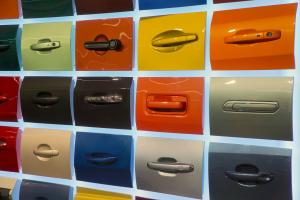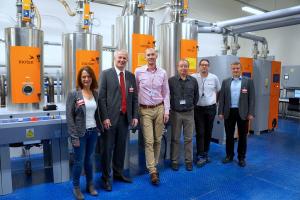Technical Report 2018-02-22
Content shown in the technical articles are the sole opinion and views of the authors or companies, which are not necessarily congruent to opinion and views of the editors.
|
Drying and Conveying Technology at WITTE Automotive Reinhard Bauer for motan-colortronic gmbh It is simply incredible what has developed from a workshop for the production of suitcase locks founded by Ewald WITTE in Velbert, Germany in 1899 into the company that it is today. WITTE Automotive is still a private, family-run business that achieved a turnover of more than EUR 670 million in 2017 with 5,200 employees in 9 European locations in Germany, Sweden, the Czech Republic and Bulgaria, all with the unaltered focus on “closing and locking”. Today WITTE Automotive is a technological leader in mechatronic closing systems for cars as part of system solutions for doors, hatches, interiors and seats. WITTE Automotive is represented globally in the USA, Mexico, Brazil, India, China, Japan and South Korea as part of VAST, the Vehicle Access Systems Technology alliance. With approximately 12,000 employees and turnover of approximately USD 1,700 million, VAST is one of the leading global suppliers in this product segment.  Abb. 1: Automobil-Türgriffe samt den dahinter befindlichen Schließmechanismen sind der Fokus des 2016 neu eröffneten integrierten Türaußengriffwerkes von WITTE Automotive im nordböhmischen Ostrov. Mittelfristiges Ziel ist eine Jahresproduktion von 20 Millionen Stück. [alle Bilder: Reinhard Bauer] The variety of shapes, colours and functions of the exterior door handles and locking units produced by WITTE Automotive Czech plant is impressive. They comply with existing crash safety regulations, are available with and without remote control as well as keyless “Passive Entry/Passive Go” operation and coordinated with the specified car colour of each order (Fig. 1 + 2). The range is completed with the patented “anti-picking” measures. The WITTE Automotive range extends far beyond exterior handles; it also includes strikers, internal door handles, keys and locks, closing aids, door checks and door brakes, door drives and door protect systems.  Abb. 2: Beispiel eines Türgriffmoduls mit integrierter Sende-/Empfangselektronik zur Realisierung eines schlüssellosen Zugangs. A comprehensive range of car seats is also available. “Energy-absorbing backrest latches and strikers minimise the load on the backrest in the event of a crash. They are part of the safety equipment for occupant protection. New seat-to-floor latches for convenient removal and installation of seats as well as the active safety backrest system (ASR) complete the WITTE range,” says David Svoboda, Division Manager Injection Moulding, in his company presentation. Uncompromising Quality of Plastic Parts As the door and flap handles of a car are in the field of vision and reach of the user, they make a considerable contribution to the sense of quality of a car thanks to their design and tactile properties. The handle modules are produced as “car sets”. A set is comprised of all door handles of a vehicle including the functions behind them. For reasons of strength, the structural parts are made of PA6 with 35 per cent fibreglass and the covers of a PC/ABS blend. Only pre-coloured material is used. Production is currently carried out on 12 injection moulding machines and there are definite plans for 10 more (Fig. 3).  Abb. 3: Gesamtansicht der Spritzgießfertigung, davor Arbeitsbereiche zur Konfektion der Spritzgussteile As much as the drying system is the “heart” of the material supply system in terms of application, the material feed on the injection moulding machine is so easy. A mixing unit was mounted on the machine to mix virgin material with regrind and an additive. Below the dosing unit there is a metal detector in order to separate any knife chips contained in the regrind. For technical details of the machine, please refer to the machine profile below. Complete Machine Transparently Operable via Master Production Computer  Abb. 4: Die Projektpartner motan-colortronic, Luger und WITTE Tschechien blicken auf eine erfolgreiche Zusammenarbeit zurück. Vln Carola Wirth, Marketing motan-colortronic, Thomas Luger, Vertretung motan-colortronic für Tschechien, David Svoboda, Bereichsleiter Spritzguss WITTE Tschechien, Jaroslav Houska, Projektkoordinator Spritzguss, Pavel Karas, Produktionsleiter Spritzguss bei WITTE-Ostrov und Zdenek Tesar, Außendienst-Mitarbeiter Fa. Luger Region Böhmen. Success through Close Partnership Finally, Head of Division Mr Svoboda, in his resumé at the start of production, summed up the essential criterion for the decision in favour of motan: “In view of the tight schedule for the construction and commissioning of our new production plant, it was important to us to minimise the technical risk for as many system components as possible. After a series of impressive reference visits, we finally decided on motan-colortronic as our system supplier and Luger as our system planner and service partner - and we were not disappointed.” (Fig. 4). The Machine Profile Potential for Eight Different Materials on 22 Injection Moulding Machines PC/ABS blends with and without fibreglass content, PA 6 with 30 per cent fibreglass in consumption quantities of 20 to 100 kg/hr, flexibly distributed over several machines in each case. All materials are fed to the injection moulding machines by the central drying system via dry air conveyance.  Abb. 5: Angeliefertes Material wird in vier Doppelkammersilos gelagert. Die Füllleitungen sind durch Schlosssicherungen gegen eine Fehlbefüllung gesichert. The eight main plastic types are processed away from the silo. Adapted to the consumption quantities, four double silos, each with 2 x 47 m3 capacity, were provided stacked on top of each other for batch separation (Fig. 5). Locking mechanisms on the coupling points reduce the potential for incorrect loading. The materials are transported between the silos and the downstream drying system via energy-saving, speed-controlled blowers. Material Drying The material types processed at WITTE are dried centrally before being transported to the machines. motan LUXOR dry air dryers of the ETAplus range are used. “ETA” stands for the Greek letter „η“, which denotes the degree of technical efficiency. (At motan, the ETA-process® stands for optimum adjustment of the drying temperature, the dry air quantity supplied, the dew point and the drying time.)  Abb. 6: Die LUXOR A Baureihe mit der energieeffizienten ETA-process® und ETA plus® Trocknungstechnologie umfasst zehn Modelle mit einer Trockenluftleistung von 80 bis 2400 m3/h. To facilitate adjustment of the drying systems, a material database is installed in the control as an additional function. It contains a basic database with the parameters of approx. 70 standard materials and can also be individually extended with a further 100 data records Conveying  Abb. 7: Die Materialleitung zwischen Trocknungsanlage und den Spritzgießmaschinen, bestehend aus Edelstahlrohren und Glas-Rohrbögen. In order to maintain the drying status of the plastic granulate as well as possible up to the injection moulding machines, dry air is used as the conveying medium. In addition, only small material batches are conveyed to the machines and then the lines are completely drained. Material Dosing on the Injection Moulding Machines All injection moulding machines are equipped with a metal separator and the gravimetric GRAVILCOLOR dosing unit with three metal separators installed on top. New material and regrind are processed on the machines in an adjustable mixing ratio. The third component is an additive.  Abb. 8: Die Funktionen und Einstelldaten der Zentralanlage werden über motan LINKnet visualisiert und fernbedient. All machine components are activated and operated via the remote-controlled electronic modules specifically developed by motan for this purpose. The silos, drying system and conveying system are monitored and controlled via the motan CONTROLnet. The system concept offers potential for further extension up to system management by means of motan LINKnet, to which all motan controls capable of communication can be connected. It enables all process sequences and application data within the motan system to be collected and logged and all connected devices to be operated. With continuous logging of the system processes, processed material batches can be assigned to the products produced and tracked. (Fig. 8) motan Group The motan Group, with its headquarters in Constance on Lake Constance, was founded in 1947. As a leading supplier for raw material handling, it is active in the fields of injection moulding, blow moulding, extrusion and compounding. The application-based product range includes innovative, modular system solutions for the storage, drying, crystallisation, conveying, dosing and mixing of raw materials for the plastic producing and processing industry. Production is carried out at locations in Germany, India and China. motan is represented in more than 120 countries with Sales and Service. With a current total of more than 500 employees, an annual turnover of approx. € 118 million is achieved. motan gmbh Otto-Hahn-Straße 14 Phone: +49 (0) 6175 792 167 Internet: www.motan.com |
 back to the list back to the list |  back to top back to top |







